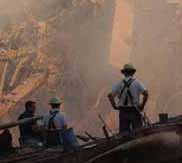
WEDNESDAY, April 7 (HealthDay News) — World Trade Center rescue workers showed lingering lung damage more than six years after exposure to the toxic dust cloud on Sept. 11, 2001 — damage that is likely permanent, researchers say.
Researchers measured the lung function of about 92 percent of the almost 14,000 New York City firefighters and emergency medical services (EMS) workers who responded to Ground Zero in the wake of the terrorist attacks.
In the year after their exposure to such pollutants as burning jet fuel and pulverized building materials, firefighters and EMS workers experienced a steep drop in average lung function. Non-smoking firefighters were especially hard hit, according to the study in the April 8 issue of the New England Journal of Medicine.
About 18 percent of firefighters who had never smoked had abnormal lung function for their age after one year, compared to 3 percent prior to the exposure. Among EMS workers, 22 percent had abnormal lung function after one year, compared to 12 percent prior to exposure, according to the study.
Over the next six-plus years, the workers showed little or no recovery in lung function, said Dr. David J. Prezant, senior author of the study and chief medical officer for the New York City Fire Department.
About 13 percent of firefighters and 22 percent of emergency medical services workers continued to have abnormal lung function six years later.
“This decline is permanent, demonstrating the need for continued monitoring and aggressive treatment,” said Prezant, who is also a professor of medicine at Albert Einstein Medical School in New York City.
“This is the largest study done to date of the most severely exposed workers — firefighters and EMS workers,” he added. “The greater exposure you had, the more decline you had.”
The rescue workers’ lung function was measured using spirometry, which gauges the rate and volume of air moving in and out of the lungs during breathing. Specifically, researchers measured forced expiratory volume, or how many liters of air workers could blow out in one second.
Firefighters and EMS workers have pulmonary function tests done every 12 to 18 months as part of their regular physicals, data that enabled the study authors to compare “before” and “after” 9/11 results.
Typically, forced expiratory volume declines gradually with age, but not nearly as severely as in the rescue workers, the study found.
In the case of the firefighters, their scores dropped an average of 371 milliliters in the first six months, or 12 times the expected decline. For EMS workers, the drop was 272 milliliters, or 10 times what would be expected, according to the study.
Low scores on the lung function tests can mean obstruction of the airways or inflammation in the lungs.
“These are healthy people who, despite their high state of fitness, have this very striking, very dramatic loss of pulmonary function after 9/11,” said Dr. Philip Landrigan, chairman of preventive medicine at Mount Sinai Medical Center in New York City. “The good news here is that the decline in function looks like it was a one-time thing. They took this one large hit and have leveled off since then. The bad news is it’s not getting any better. It looks like this is a permanent change.”
The study included first responders who reported to Ground Zero between Sept. 11 and Sept. 24, 2001. Those who were there the day of the attacks, when the toxic cloud was most intense, had greater respiratory declines than those who went to the scene on subsequent days, Prezant said.
While a greater percentage of EMS workers had abnormal function, that’s because EMS workers started out, on average, less fit than the firefighters and had lower scores on pulmonary function tests to begin with, Prezant explained.
Aggressive treatments, such as steroids, of rescue workers through programs such as the World Trade Center Medical Monitoring and Treatment Program are probably helping to prevent further lung function declines, Landrigan said.
The impact of the reduced lung function on rescue workers varies by individual, with many continuing to experience wheezing, shortness of breath and coughing, Prezant said.
Typically, firefighters experience a short-term decrease in lung function after heavy exposure to smoke from building or woodlands fires. The World Trade Center attacks spewed even harsher pollutants, the study authors said.
In addition to normal smoke, the firefighters and paramedics were breathing in burning jet fuel and particulate matter from the World Trade Center itself. The fine particles overwhelmed the normal filtration systems of the nose and throat and settled deep into the lungs, Landrigan said.
“There is no question that being caught in the cloud was a terrible exposure,” Landrigan said. “The dust cloud was so thick and the concentrations of toxins in the air were so high, they inhaled massive amounts of it.”
On March 19, a federal judge rejected a settlement that would have given World Trade Center rescue workers at least $575 million to compensate them for their ailments, saying the compensation wasn’t enough.
More information
The World Trade Center Medical Monitoring and Treatment Program has more on 9/11-related medical issues.

